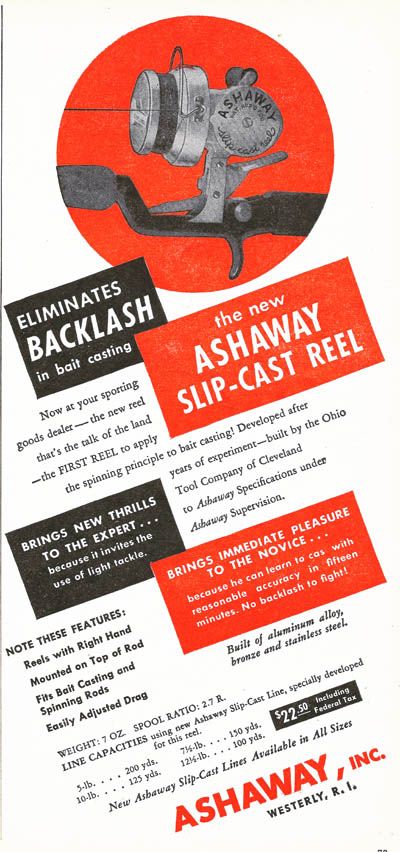"Spinning” - “Slip-Cast” - “Spincast”
From the pages of the January 1948 issue of Outdoor Life comes this advertisement for the “new Ashaway Slip-Cast Reel.” To today's angler the Ashaway Slip-Cast reel looks at first glance like an open face spinning reel that has been mounted upside down on a bait casting rod. Close observation will show that once the bail was opened the line was controlled by use of a lever pushed by one's thumb which raised (“teeter-toter” fashion) a mechanical finger to block or release line from the spool.
In many ways this reel was the predecessor of so-called “spincast” reels that were closed faced and sat upright on older bait casting rods. The whole idea of “spinning” as a fishing method was so new at this time that many folks just didn't know what to make of it. Magazines contained regular articles and many books were published explaining “spinning” to the public as if it were too mysterious for the average person to figure out it on their own. The Term “slip-cast fishing” was occasionally used by fishing writers of the day along with term “thread-line fishing.” I am unaware of any tackle company using the “Slip Cast” nomenclature other than Ashaway.

The portion of this ad entitled ”NOTE THESE FEATURES” alludes to two aspects of the arrival of spinning that seem lost in today's memory. The first is the feature “right hand” crank. Unless you were there, it is hard to impress on today's fisherman just how foreign the left hand crank on most spinning reels seemed to those of us who grew up with the standard bait casting reel. Ashaway was obviously trying to cash in on this prejudice among older fishermen. It also points out that the reel is “mounted on top of the rod” where it had always been and where many baitcasters felt that it still belonged. This feature also meant that it would work on that bait casting rod which Ashaway presumed you already owned.
Ashaway was of course, a line company first and foremost. One of the problems with the early use of spinning reels was that braided line was the only option until monofilament (of an acceptable quality) became available. Most lines that were used for “spinning” at that time were thin braided nylon that usually tested somewhere between 4 and 8 pounds. The following pictures show two seemingly identical spools of 5 pound test line. I cannot detect the slightest difference in the line itself, but when we look on the other side of the spools, one is labeled “Slip-Casting Line for use on Slip-Casting reels” and the other is labeled “Spinning Line for use on Spinning Reels.”
Both these spools were shown in the 1951 catalog (compliments of John Etchieson). Only braided "spinning" line is listed in 1955. My thoughts are that this was an attempt to corner the “Slip-Cast” market while also selling to those who chose “spinning” reels. Eventually Ashaway deferred to the term “spinning” when it became obvious that would be the name which was, in the end, accepted by the fishing public.


-- Bill Sonnett
My grandfather Carl K Monty designed and patented a fishing reel that was a slip casting reel
ReplyDelete